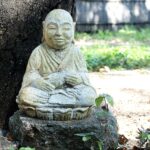
Bodhisattva
An awakened/ enlightened or ‘enlightening’ being who remains in the world of suffering with the vow to free all beings. The bodhisattva ideal is closely associated with Mahayana Buddhism.
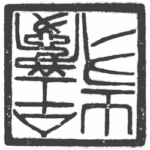
Ch’an
The Chinese word for Zen, derived from the Sanskrit dhyanaI (meditation). Densho
Literally, “hall bell.” The large bell hanging outside the zendo, used to announce the time for ceremonies and dharma talks.

Dharma
The word means “teachings”, also law or truth, and can also refer to phenomena, all beings, all things.
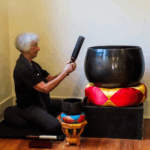
Dōan
This the Sōtō Zen term for a person trained to rings bells in the zendo, play other instrument, and lead chanting. At AZC, the dōan acts as timekeeper and sounds the small bell that marks the beginning and end of each period of zazen. The dōan also rings the small and large bells during service and ceremonies and uses wooden clappers to begin and end kinhin (walking meditation). Other positions are named in the following entry.

Dōan-ryo
The group of people who serve in temple roles, including the dōan, fukudo (sounds drums and han), chiden (takes care of altars), jiko (carries incense for priest), and kokyo (chant leader).

Dokusan
Dokusan is the Japanese term for “going alone to the teacher;” a formal and private face-to-face meeting with a Dharma-Transmitted Zen teacher. A fully authorized Zen teacher is a priest who has received dharma transmission from another fully transmitted teacher, which confers permission to guide students independently and to ordain and transmit priests, as well as offer the precepts to lay students. The format and length of the meeting varies with the teacher. As a general rule, dokusan is focused on the student’s personal practice and experience. Meeting in dokusan is a critical element of Zen training and an important part of sesshin practice. Face to face meetings are encouraged (rather than by video).
See also Practice Discussion.

Doshi
The priest who leads zazen, service, and ceremonies by offering incense and leading prostrations and bows during service.

Eightfold Path
The Eightfold path was taught by the Buddha as the 4th of the Four Noble Truths (see below): the end of suffering.
- Right View (or Understanding)
- Right Thought (or Resolve)
- Right Speech
- Right Conduct
- Right Livelihood
- Right Effort
- Right Mindfulness
- Right Concentration

Eko
The dedication that is chanted at the end of a ceremony, dedicating the merit and energy of our practice to all beings, and sometimes to specific persons or intentions.

Four Noble Truths
The Buddha’s motivation for leaving home and taking up a spiritual life was to understand duhkha (suffering) and find a solution to suffering. The Four Noble Truths are his expression of suffering (or “unsatisfactoriness”) and its resolution.
- Dukkha characterizes our lives.
- The cause of dukkha is grasping for experiences and things, and our attachment to keeping them.
- There is a way out; grasping can be ended and thus dukkha can be ended.
- The way to end dukkha is the Eightfold Path.

Fukudo
The doan who sounds the han or densho, two instruments which announce service and zazen, and who plays the mokugyo or drum during service.
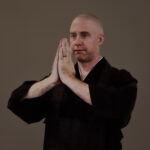
Gassho
(Literally: “palms together.”) A mudra, or hand position, that expresses nonduality. The palms are joined so that the fingertips are at the height of the nose. The hands are approximately one fist width away from the face, and the arms are relaxed but held away from the body. The gesture is used as a greeting, farewell, and to indicate respect.

Gatha
A short sutra, used to set an intention as we undertake an action.. As an example, here is a meal gatha often chanted before eating informally:
“We venerate the three treasures and give thanks for this food, the work of many people, and the offering of other forms of life.”
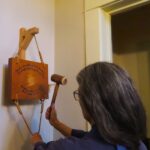
Han
In Zen monasteries, a wooden board struck with a mallet by the fukudo to announce the start of zazen. The pattern of strikes always includes three roll-downs: the first ending with one strike, the second with two, and the third with three. The han is sounded for 10 minutes, every 50 seconds between each roll-down. Practitioners are expected to be in the zendo and settled in their seats by the second roll-down, i.e. about 3 minutes before the scheduled start of zazen.

Hinayana
(Literally: “small vehicle.”) One of the three main branches of Buddhism, the other two being Mahayana (great vehicle), and Vajrayana (indestructible vehicle). Hinayana is considered by most to be the oldest form of Buddhism. Because “small vehicle” has at times been used as a derogatory term by other traditions, many followers prefer to use the term Theravada (Teaching of the Elders).

Inkin
A portable handbell, rung with a small metal striker. Frequently used in processions.

Ino
One of the core positions of temple practice leadership, the Ino is the zendo (meditation hall) leader responsible for training the doan-ryo, coordinating ceremonies, and helping to maintain and teach zendo forms.
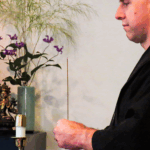
Jiko
The attendant who carries incense for the Doshi.

Jisha
The ceremonial attendant to an Abbot or other teacher

Jukai
Jukai is “giving and receiving the Precepts,” a ceremony in which lay students vow to follow and express the Sixteen Bodhisattva Precepts. During the ceremony, initiates receive a lineage on paper that traces their relationship to Buddha through our Zen ancestors, as well as a new name, and a rakusu (which they have hand-sewn) from a lineage-holding priest (“dharma transmitted”).

Jundo
Broadly speaking, “jundo” can mean any ritual circuit or circumambulation. When a resident is leaving AZC, they make a jundo to receive the thanks of the community with bows as they pass. After offering incense and bowing at the altar, the priest opening the zendo for morning meditations may walk around the zendo behind the meditators in “kentan,” or “inspection of the sitting platform.” As the Doshi passes, meditators raise their hands in gassho without bowing; this joins Doshi and sitters in mutual acknowledgement.
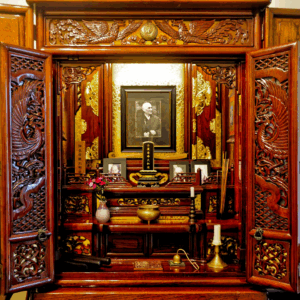
Kaisando
The Founder’s Hall, a memorial building or shrine for the founder of a temple. At AZC the kaisando is a large cabinet at the top of the stairs and holds a photograph and memorial tablet for our founder, Zenkei Blanche Hartman, who passed away on May 13th, 2016. Photos of deceased SFZC abbots and paintings of the two founders of Japanese Soto Zen, Dogen Zenji and Keizan Zenji are also housed in the kaisando. It is respectful to pause and bow to the kaisando when you pass it and its doors are open.

Karma
The Buddhist doctrine of cause and effect. The effects are of intentional action taken with body, speech, or mind. Cause and effect is complex and may not manifest directly or immediately.

Koan
Originally in China, a public record or case. In Zen, a story or vignette featuring a teaching and student or students in dialogue. The questions and answers in the dialogues point directly to reality and often produce an awakening experience. Usually associated with Rinzai Zen, they are used in Soto Zen as teaching tools. Dogen collected 300 of them, and they are referred to throughout his written teaching.
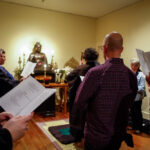
Kokyo
The chant leader during service, who announces the chant, helps set the pace of chanting, and also offers the dedications during service (eko).

Kyosaku
A wooden stick, roughly a yard long and flattened at one end, offered on request to strike the shoulders of sleepy meditators to refresh the body and mind. Not a punishment, and no longer in use at AZC or SFZC.

Mahayana
Literally: “Great Vehicle.” One of the three main branches of Buddhism, the other two being Hinayana (small vehicle) and Vajrayana (indestructible vehicle). Mahayana emphasizes practice and awakening with and for all beings, rather than individual release from suffering and rebirth.

Mindfulness
Body and mind awareness; living in the present moment. In Soto Zen, expressed as menmitsu, careful attention to everything, continuous intimacy with experience and things.
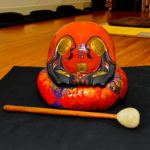
Mokugyo
(Literally: “wooden fish.”) A traditional Japanese temple instrument played during services to set the pace or “heartbeat” of certain chants. May be plain wood or lacquered.

Mondo
A short Zen dialogue between teacher and student. Now sometimes called “dharma inquiry”. The student asks a question, or makes a presentation, and the teacher responds directly and immediately, pointing to nonduality.

Mudra
Mudra means “stamp”. A ritual position of the body which is symbolic of a certain attitude or activity, such as teaching or protecting. Although mudra technically refers to the whole body, usually the focus is on the hands. Each hand position is symbolic of a certain characteristic such as fearlessness or teaching.

Nirvana
(Literally: “cessation or extinction.”) Sometimes compared to blowing out a candle; clinging and desire are burned out. Nirvana simply means an end to samsara, the world of suffering. It is also sometimes defined as the other side of samsara.

Okesa
From the Sanskrit “Kashaya,” a kesa is a rectangular, patched robe made and worn as monks have done since the Buddha’s time. (The prefix “o” in Japanese means ‘honored’.) It wraps around the body and is draped over the left shoulder, leaving the right shoulder uncovered. Black is worn by priests in training; dharma transmitted teachers wear brown. Ceremonial okesa can be very elaborate and in various colors.
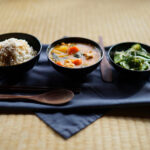
Oryoki
This has come to mean a certain kind of formal, ritualized eating, but the word oryoki actually refers to the specific collection of bowls and utensils used to eat. An elaborate set is traditionally given to a priest on their ordination. In our temple both priests and lay persons use oryoki, eating while seated on a cushion or in a chair with a small table. The meal is silent except for chanting before each phase of the meal.

Practice Discussion
Practice discussion is an informal meeting with a dharma leader. A student may bring up practice-related questions, present their understanding of the Dharma, and more generally engage in a discussion of their experience in zazen and its intersection with daily life. These meetings provide a time for the leader to give individualized instruction and to assess the student’s understanding. Both dokusan and practice discussion are offered during the weekly zazen schedule and during retreats, and sometimes outside the regular schedule by special arrangement.

Practice Leader
Usually, a person who has been shuso and who is empowered to hold practice discussions and give dharma talks, lead classes, and sometimes retreats.

Rakusu
A small version of Buddha’s patched robe, suspended from cloth straps and worn around the neck. Usually, each person sews their own and receives it from the Preceptor during Jukai, the ceremony of receiving the Bodhisattva precepts. Lay persons and priests wear rakusu in different colors. The back of rakusu is inked with the student’s Dharma name, their teacher’s name, the date and place of the ceremony, and sometimes a verse or image.

Rinzai
One of the two main schools of Zen still active in Japan, the other being Sōtō. Rinzai, which originated in China, was the first school of Zen to be brought to Japan. Its initial introduction near the end of the 12th century did not take hold, but a subsequent transfer from China did succeed. The Rinzai tradition places emphasis on dokusan and systematic study of koans.

Rohatsu
A retreat around the time of the enlightenment of the Buddha, which traditionally is celebrated on the eighth of December. Traditionally the most intensive retreat of the year.

Roshi
Venerable master of Zen. Not a self-assigned title, but a senior ordained teacher with dharma transmission (authorization to teach independently) may be called roshi by their community as a mark of respect.

Ryo
A Japanese word meaning “chamber” or “section,” for example, the doan ryo (“instrument player section”) or the tenzo ryo (“head cook section”).

Samsara
In Buddhist thought this is the continuing cycle of birth, death, and rebirth. All beings are trapped in this unpleasant cycle until they reach enlightenment. Samsara is looked upon in a negative light because of all the suffering that life entails, as elucidated in the First Noble Truth. The cause of this cycle is craving, as elucidated in the Second Noble Truth. Belief in samsara does not necessarily require a belief in reincarnation in it strictest, traditional sense, and many people practice Zen but do not believe in reincarnation.

Samu
Work Practice. This is silent work, usually physical, bringing the mind of zazen into activity in a group.

Sangha
Zen community, or group practicing together. In its largest sense, all living beings are sangha, though more commonly the term means those practicing together. In Theravada tradition, the term refers specifically to the community of ordained monks or nuns.

Sensei
A teacher. The title is placed after the teacher’s name rather than before (e.g. Juana Villareal Sensei).

Service
A period of bowing, chanting, and making offerings to the Buddhas and Ancestors.

Sesshin
(Literally: “gather or touch the mind.”) An intensive meditation retreat usually lasting three, five, or seven days. The word “retreat” may be misleading, however, as the effect of a sesshin is often to let more of the world into our lives, instead of escaping from it. Better to say that a sesshin is a silent retreat that involves many periods of zazen and the opportunity to have private interviews with a teacher (see dokusan). Meals are often eaten oryoki style, and periods of samu are generally included.

Shashu
A mudra used when standing or walking in formal practice situations. The fingers of the left hand gently make a fist around the thumb and the right hand gently covers the left. Arms are relaxed and held at waist level. If wearing a rakusu, hands are held under the rakusu.

Shikantaza
“Just sitting.” Soto Zen’s practice of zazen. Literally to sit upright and not do anything else.

Shoten
The person who sounds the densho to announce events in the Buddha Hall.

Shuso
The head student (literally, “head seat”) for a practice period. The shuso shares responsibility for leading the practice period with the Guiding Teacher, and usually to offer talks on practice and meet with sangha.

Soji
A brief period of mindful work, often immediately after morning zazen.

Sutra
A Buddhist text or scripture regarded as having been spoken by the Buddha, but sometimes used to refer to other teachings. We chant sutras together as part of our practice, letting the teachings into our ears, minds and hearts.

Tan
A raised platform for sitting in a zendo. (Not a feature of AZC’s zendo.)

Tanto
The head of practice of a monastery or temple, usually second in command to the Abbot or Head Teacher. The tanto is an experienced senior practitioner who oversees the Ino and the training of Zen students. As they are familiar with other leadership positions in the temple, they are empowered to offer guidance on monastic conduct, forms, and ceremonies.

Tatami
Tatami
Japanese-style, thick woven straw floor mats. Always remove shoes before stepping on tatami.

Teisho
A formal talk by a senior Zen teacher. The talk is not a sermon or an academic lecture; it is more a presentation of insight than an exposition of factual knowledge. Though not limited to sesshin, a daily teisho traditionally is part of the schedule during sesshin. Teisho are recorded but usually note-taking is discouraged, and listeners sit upright in zazen during the talk. The purpose of this practice is to hear the dharma on the occasion of the talk, and hear the questions and answers which may follow, but not to treat the talk as a lecture to study.

Tenzo
The head of kitchen practice for a monastery or retreat. Traditionally the role of tenzo was a senior position in Zen monasteries, and one of the six positions of temple officers.

Zabuton
A large, rectangular mat of fabric-covered cotton batting, usually used with a zafu or sitting bench.
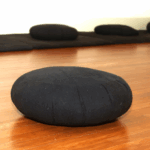
Zafu
A round cushion used for zazen.

Zazen
“Dynamic awareness in an upright posture,” or seated “zen” – seated concentration. It is not something done with the mind, but with one’s whole being. Zazen is usually usually done in periods of 30 to 50 minutes at a time. Zafu, kneeling benches, and chairs are options for seating. Zazen does not involved pushing away thoughts, ignoring pain, going into a trance, etc. It is just totally engaged in the activity of sitting and not adding anything. Ask for instruction.

Zazenkai
A Zazenkai is “to come together for meditation”. It is a retreat focused on sitting (zazen) that is usually less intensive and of shorter duration than sesshin. At AZC, most Zazenkai are half-day in length (8 am – noon).

Zen
Zen, or Ch’an as it was originally called, is a branch of Mahayana Buddhism that first appeared in China in the sixth and seventh centuries CE, according to tradition, by the Indian monk Bodhidharma. It was influenced by the indigenous Chinese religion, Taoism. From China, Zen moved on to Japan, Korea Vietnam, and other regions.
The word ch’an is a transliteration of the Sanskrit word, Dhyana, meaning concentration (i.e. meditation). The main practice of Zen Buddhism is zazen – just sitting.
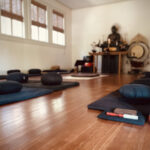
Zendo
Zen room or hall. This is the main room for zazen and other Zen practices. An altar is not essential but usually one is present. Cushions, chairs and benches to support sitting are available.
Share this:
- Click to email a link to a friend (Opens in new window) Email
- Click to share on Facebook (Opens in new window) Facebook
- Click to share on Telegram (Opens in new window) Telegram
- Click to share on Bluesky (Opens in new window) Bluesky
- Click to share on X (Opens in new window) X
- Click to share on LinkedIn (Opens in new window) LinkedIn
